June 2012 Retail Sales decreased, by -0.5%, and this month one cannot blame just falling gas prices. Autos & Parts alone dropped -0.6% while auto dealers, part of Autos & Parts, declined -0.7%. Minus autos & parts, retail sales also decreased, -0.4%. This is the 3rd month in a row retail sales have declined. June Retail sales are up 3.8% from the same time last year. Retail sales are reported by dollars, not by volume, so dropping prices often reports as a decline in sales.

For the quarter, April to June, retail sales decreased -0.2%. In comparison of Q2 against a year ago, retail sales are up 4.7%. Below is a graph of quarterly retail sales percent change. We have not seen a quarterly decline like this since Q1 2009.
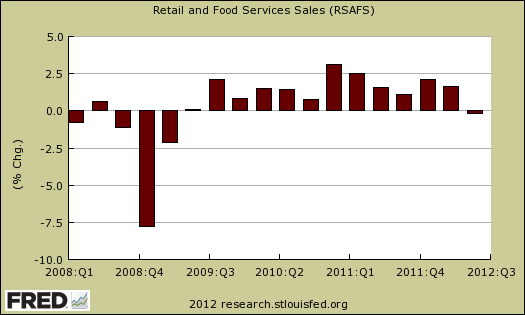
Total retail sales are $401.515 billion for June. Below are the retail sales categories monthly percentage changes. These numbers are seasonally adjusted. General Merchandise includes super centers, Costco and so on.
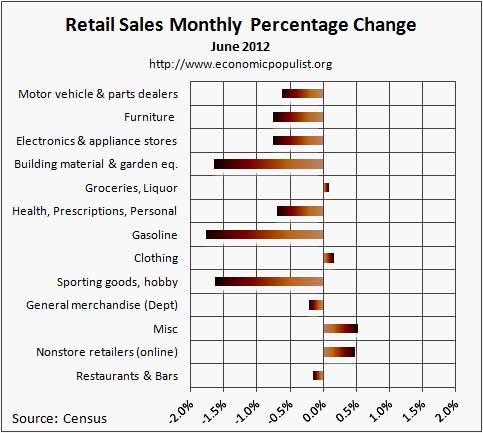
Retail trade sales are retail sales minus food and beverage services. Retail trade sales includes gas, and is down -0.5% for the month, up 3.5% from last year.
As we can see retail sales this month cannot be blamed on declining gas sales (due to dropping prices), even though gas retail sales declined -1.8%. Building material, garden equipment & supplies dealers had yet another pretty bad month, down -1.6%. Sporting goods dropped -1.6% as well for the month. Below are the June retail sales categories by volume. As we can see, cars are king when it comes to retail sales.
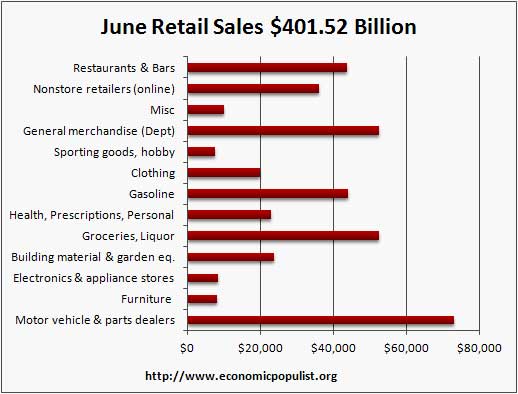
For reference sake, graphed below are weekly regular gasoline prices, so one can see what happened in June.
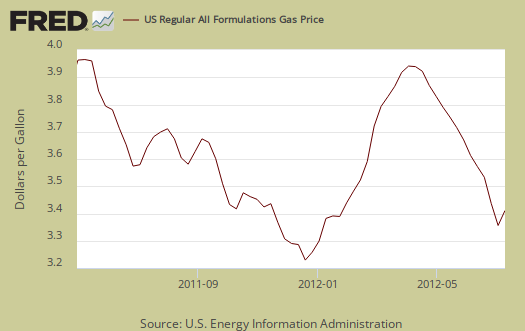
The below chart breaks down seasonally adjusted retail sales by category as a percentage of total June sales by volume. One can see how dependent monthly retail sales are on auto sales by this pie chart.
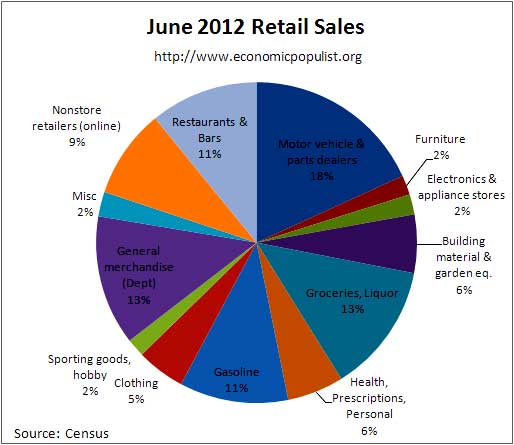
Retail sales correlates to personal consumption, which is about 70% of GDP growth. Yet GDP has inflation removed from it's numbers. This is why Wall Street jumps on these retail sales figures. Below is the graph of retail sales in real dollars, or adjusted for inflation, so one gets a sense of volume versus price increases. Below is the annualized monthly percentage change in real retail sales, monthly.
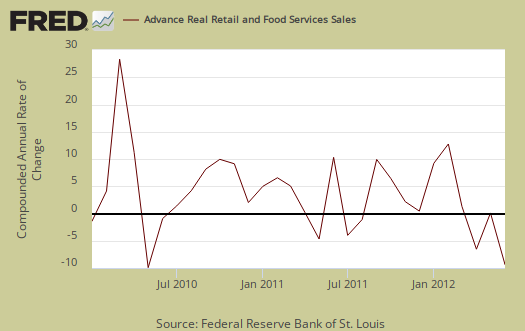
To obtain real values, retail sales are deflated using CPI. Below are the real retail sales quarterly annualized percent change. Folks, we might see negative consumer spending in the Q2 GDP report.
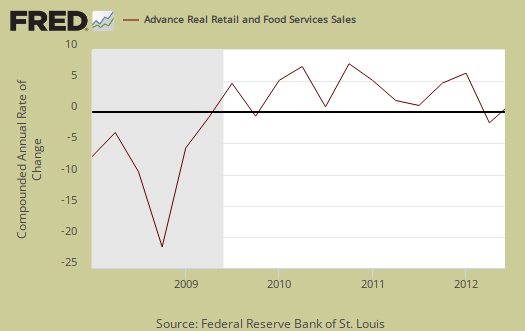
This report implies personal consumption will be weak for Q2 2012 GDP. We do not know the exact percentage real retail sales is of personal consumption, but it's significant. There are other elements which are part of PCE. To wit, below is a graph of real PCE against real retail sales, quarterly. See how closely the two track each other? PCE almost looks like a low pass filter, an averaging, removal of "spikes", of real retail sales. Also notice when quarterly real retail sales has been slightly negative, real personal consumption isn't guaranteed to also be negative? Folks, this month's retail sales report is assuredly ushering in bad economic growth news. While we cannot say we'll see negative PCE, I think it's clear we can see PCE will be less than Q1 PCE. Here are our overviews for PCE. Q2 GDP will be out on the 27th with June PCE released the 31st of July.

Retail sales are not adjusted for price increases, not reported in real dollars. Real economic growth adjusts for inflation. Retail sales has variance, margins of error, and is often revised as more raw data comes into the U.S. Department of Commerce (Census division). For example, this report has an error margin of ±0.5%. Data is reported via surveys, and is net revenues of retail stores, outlets. Online retail net revenues are asked in a separate survey of large retail companies (big box marts). This is also the advanced report. To keep the monthly nominal percentage changes in perspective, below is the graph of monthly percentage changes since 2008.

Seasonal adjustments are aggregate and based on events like holidays associated with shopping, i.e. the Christmas rush.
Advance reports almost always are revised the next month as more raw sales data is collected by the Census.
Here is last month's overview, unrevised.

the utlimate retail sales overview, just revised and updated
Folks, we've outdone ourselves with this month's retail sales overview. Check this out, even if you read it before! The updates include real quarterly retail sales and plotting that against real personal consumption. This has implications for Q2 GDP.
I like going into this report is just detail after reading so much bogus stuff out there claiming cell phone sales are gonna save the economy and all sorts of ridiculous rot. That's why this post is graph-o-rama, to show it is the auto industry, sales which are the backbone of the economy, to this day, not cell phone sales.